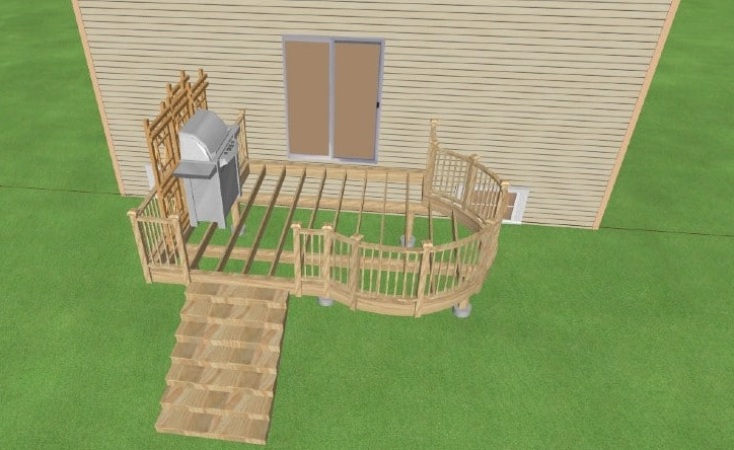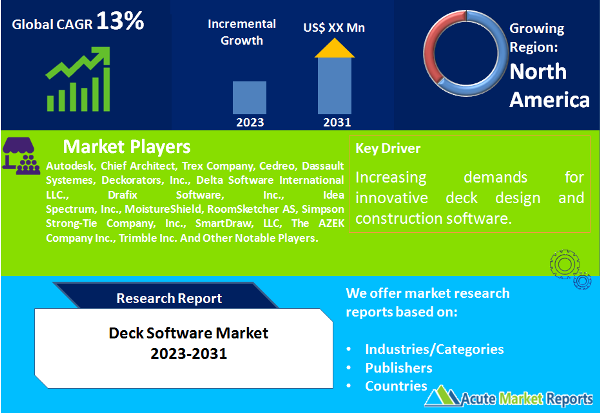
The deck software market is a dynamic sector that provides software solutions for designing, planning, and managing decks in residential and commercial settings. The deck software market is expected to exhibit a CAGR of 13% during the forecast period of 2025 to 2033, driven by increasing demands for innovative deck design and construction software. However, it also faced challenges related to the restraint of limited adoption in some regions. The deck software market is poised for continued growth, driven by the demand for customized deck designs, technology advancements, and increased adoption of cloud-based solutions. Limited adoption in certain regions remains a restraint. Market segmentation by deployment and application, along with geographic trends, further shape the industry's dynamics. Key players are expected to maintain their competitive edge through innovation and customer-centric strategies, with revenues projected to rise from 2025 to 2033. Looking forward to the period from 2025 to 2033, the market is expected to continue evolving with the integration of new technologies and expanding application areas.

Rising Demand for Customized Deck Designs
In 2024, the Deck Software Market witnessed substantial growth driven by the rising demand for customized deck designs in residential and commercial projects. Homeowners and businesses sought unique, aesthetically pleasing decks that fit their specific needs. Deck software provided the tools necessary to design and visualize these custom creations. This trend is expected to persist from 2025 to 2033 as personalization and customization remain essential factors in deck design.
Technology Advancements in 3D Visualization
Technology played a crucial role in the market's growth in 2024, with advancements in 3D visualization tools. Deck software allowed users to create detailed, realistic 3D models of their deck projects. This feature not only enhanced design capabilities but also improved communication and collaboration among stakeholders. As technology continues to evolve, it is expected to remain a key driver, with a high CAGR from 2025 to 2033.
Increased Adoption of Cloud-Based Solutions
Cloud-based deployment options gained prominence in 2024 due to their flexibility and accessibility. Users can access their deck design software from anywhere, collaborate in real time, and receive updates seamlessly. This trend is expected to persist in the forecast period from 2025 to 2033 as cloud solutions become the preferred choice for many users.
Restraint in the Deck Software Market
Despite its growth, the Deck Software Market faces a restraint related to limited adoption in some regions. In 2024, certain areas struggled to embrace this technology due to factors like limited internet connectivity or a lack of awareness about the benefits of deck software. It is expected that addressing these adoption challenges will continue to be a restraint from 2025 to 2033, requiring efforts to increase awareness and accessibility.
Market Segmentation by Deployment: Cloud Solutions Dominates the Market
The Deck Software Market can be segmented by deployment into two main categories: Cloud and On-premise. In 2024, both deployment methods contributed significantly to the market's revenue. Cloud solutions were favored for their accessibility and collaboration features, while on-premise software attracted users seeking more control over their data. During the forecast period from 2025 to 2033, cloud-based solutions are expected to exhibit the highest CAGR, as the demand for remote work and collaboration tools continues to grow.
Market Segmentation by Application: Commercial Applications to Promise Significant Opportunities during the Forecast Period
Another crucial segmentation factor is the application of deck software, which can be divided into Residential and Commercial use. In 2024, both application areas contributed significantly to market revenues. Residential applications were driven by homeowners' desire for customized decks, while commercial applications included businesses in the hospitality, tourism, and event industries. During the forecast period from 2025 to 2033, commercial applications are expected to exhibit the highest CAGR, as businesses increasingly invest in creating attractive outdoor spaces to attract customers.
North America Remains the Global Leader
Geographically, the Deck Software Market exhibits diverse trends. North America recorded the highest revenue percentage in 2024, thanks to its robust residential and commercial construction sectors. However, the Asia-Pacific region is expected to have the highest CAGR from 2025 to 2033, as it witnesses rapid urbanization and a growing demand for modern deck designs.
Market Competition to Intensify during the Forecast Period
The Deck Software Market is characterized by competition among key players, such as Autodesk, Chief Architect, Trex Company, Cedreo, Dassault Systemes, Deckorators, Inc., Delta Software International LLC., Drafix Software, Inc., Idea Spectrum, Inc., MoistureShield, RoomSketcher AS, Simpson Strong-Tie Company, Inc., SmartDraw, LLC, The AZEK Company Inc. and Trimble Inc. These companies have consistently invested in research and development to enhance their software solutions and gain a competitive edge. In 2024, they recorded substantial revenues, and it is expected that their strategic investments will continue to yield high returns from 2025 to 2033. Key strategies include the integration of advanced features, user-friendly interfaces, and enhanced customer support to maintain their market leadership.
Historical & Forecast Period
This study report represents analysis of each segment from 2023 to 2033 considering 2024 as the base year. Compounded Annual Growth Rate (CAGR) for each of the respective segments estimated for the forecast period of 2025 to 2033.
The current report comprises of quantitative market estimations for each micro market for every geographical region and qualitative market analysis such as micro and macro environment analysis, market trends, competitive intelligence, segment analysis, porters five force model, top winning strategies, top investment markets, emerging trends and technological analysis, case studies, strategic conclusions and recommendations and other key market insights.
Research Methodology
The complete research study was conducted in three phases, namely: secondary research, primary research, and expert panel review. key data point that enables the estimation of Deck Software market are as follows:
Market forecast was performed through proprietary software that analyzes various qualitative and quantitative factors. Growth rate and CAGR were estimated through intensive secondary and primary research. Data triangulation across various data points provides accuracy across various analyzed market segments in the report. Application of both top down and bottom-up approach for validation of market estimation assures logical, methodical and mathematical consistency of the quantitative data.
| ATTRIBUTE | DETAILS |
|---|---|
| Research Period | 2023-2033 |
| Base Year | 2024 |
| Forecast Period | 2025-2033 |
| Historical Year | 2023 |
| Unit | USD Million |
| Segmentation | |
Deployment
| |
Application
| |
End-Use
| |
|
Region Segment (2023-2033; US$ Million)
|
Key questions answered in this report